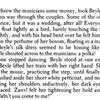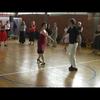4: Excerpt, "Romance of a Horse Thief," 1986, and video clip, pas d’espagne demonstration by Steve Weintraub and Avia Moore, 2009.
In chapter 12, Zanvl and Beyle dance together at a wedding, even though traditional Jewish law prohibits men and women from dancing together. The English translation of the novella refers to Zanvl and Beyle’s scandalous dance as a polka. In the Yiddish original, it is actually a Russian ballroom dance called a pas d’espagne, which comes from the French for “Spanish Step.”
Suggested Activity: Have students read the short scene where Zanvl and Beyle dance together. What kind of dance do they imagine based on the text (movements, speed, closeness?) How are their motions described? How does Opatoshu indicate the transgressive aspects of this dance? How does he convey temptation? What sort of contemporary dances capture this same energy?
Next, have students watch the video of Yiddish dance leaders Steve Weintraub and Avia Moore dancing the pas d’espagne. Ask them to describe the movements they see. Was this the kind of dance they were expecting based on the text? Why or why not?
Sources: Joseph Opatoshu, Romance of a Horse Thief, trans. David G. Roskies, in A Shtetl and Other Yiddish Novellas, ed. Ruth R. Wisse (Detroit: Wayne State University Press, 1986), 180.
“pas d’espagne demonstration by Steve Weintraub and Avia Moore,” Youtube. Accessed March 3, 2020.


